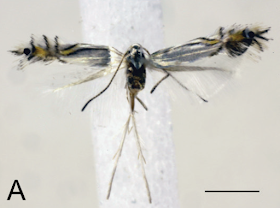Moths of the Family Gracillariidae are found throughout the world except
on Antarctica and some remote islands. Their larvae are leaf-miners,
worm-like caterpillars that live in tunnels inside leaves. Some groups
of Gracillarid Moths are specialist miners of the leaves of some of the
most ancient groups of Angiosperms (flowering plants) such as Laurels
and Magnolias, and fossils leaf mines that resemble those of the Moths
have been found in fossilised leaves from the Cretaceous of North
America, which also suggests this is an ancient association. However the
oldest fossils of the Moths themselves are from (Eocene) Baltic amber,
and there is no way to connect these moths to the leaf mines, so it is
quite conceivable that the Moths have only recently colonised these
plants, and that the burrow shape is coincidental, simply a good shape
for a leaf mine in this sort of leaf.
In a paper published in the journal ZooKeys on 18 February 2018, Natalia Kirichenko of the Sukachev Institute of Forest, the Siberian Federal University, and Zoologie Forestière, Paolo Triberti of the Museo Civico di Storia Naturale in Verona, Shigeki Kobayashi of the Entomological Laboratory at Osaka Prefecture University, Toshiya Hirowatari of the Entomological Laboratory at Kyushu University, Camiel Doorenweerd of the Department of Plant and Environmental Protection Sciences at the University of Hawai'i, and the Naturalis Biodiversity Centre, Issei Ohshima of the Department of Life and Environmental Sciences at the Kyoto Prefectural University, Guo-Hua Huang of the Hunan Provincial Key Laboratory for Biology and Control of Plant Diseases and Insect Pests at the Hunan Agricultural University, Min Wang of the Department of Entomology at the South China Agricultural University, Emmanuelle Magnoux, also of Zoologie Forestière, and Carlos Lopez-Vaamonde, again of Zoologie Forestière, and of the Institut de Recherche sur la Biologie de l’Insecte at the Université François-Rabelais de Tours, describe three new species of Leaf-mining Moths from Dogwood trees, Cornus sp., in Asia. All are placed in the genus Phyllocnistis.
The first new species is named Phyllocnistis indistincta, in reference to the colouration of the forewing, with indistinct yellow-white bands. This species has wing-spans of between 4.0 and 6.5 mm, and is white in colour with yellow, orange, brown and black markings. It was found on Wedding Cake Trees (Cornus controversa), Flowering Dogwoods (Cornus florida), and Korean Dogwoods (Cornus kousa), on Honshu, Shikoku and Kyushu islands, Japan.
Phyllocnistis indistincta, male specimen. Scale bar is 1 mm. Kirichenko et al. (2018).
The second new species described is named Phyllocnistis verae, in honour of Vera Kirichenko, the mother of Natalia Kirichenko. This species has wingspans of 6.0-6.1 mm and is white with dark brown and orange markings. This species was found at a single location, beside the Yenisei River in Krasnoyarsk Krai, Siberia, on a White Dogwood tree, Cornus alba.
Phyllocnistis verae, male specimen. Scale bar is 1 mm. Kirichenko et al. (2018).
The final new species is named Phyllocnistis saepta, meaning 'to block' in reference to the shape of a blotch on the forewing. This species has a wingspan of 5.0 mm and is white in colour with orange, brown and black markings. This species was found living at a single location in Weixi County, in Yunnan Province, China, on a Large-leaf Dogwood, Cornus macrophylla.
Phyllocnistis saepta, male specimen. Scale bar is 1 mm. Kirichenko et al. (2018).
See also...
Follow Sciency Thoughts on Facebook.









